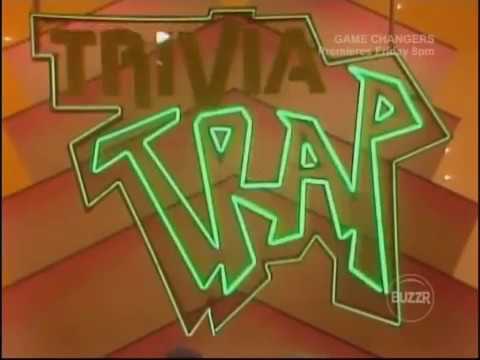|
 Here comes the fascinating world of trivia, where even a right answer can catch you in a trap - on... Here comes the fascinating world of trivia, where even a right answer can catch you in a trap - on...
SHOW: Trivia Trap
AIR DATES: October 8, 1984 to April 5, 1985
CREATOR: Mark Goodson
PACKAGER: Mark Goodson Productions
HOST: Bob Eubanks
WATCH IT HERE: YouTube
In 1981, a board game was created by...ah, you already KNOW all this by now. The POINT is that, in the 80s, trivia was the big thing in this country. EVERYONE was into it, even those who thought it was a waste of time. And leave it to Mark Goodson to exploit this long after his partner Bill Todman passed on. So he put together what he felt was a unique trivia contest called "Trivia Trap" where, as the spiel implies, even a right answer can trap you and your teammates and cost you the game. And, yes, it was unique...but it was also a bit complicated for 80s audiences. When those who played "Trivial Pursuit" saw a show based on trivia, they were up for it...but when it turned out to be more complicated than "answer questions to win", I dare say they felt...well, trapped by false promises.
HOW WAS IT PLAYED?
MAIN GAMEPLAY
Two teams of three played, divided by ages. The contestants under the age of 30 were "Juniors" and wore blue sweatshirts, those 30 and over were "Seniors" and wore red sweatshirts. The first team to reach $1000 wins the game, becomes champions and plays for $10,000 in the bonus round.
OPENING ROUND(S)
The original format has teams looking at two rows of monitors with possible answers to a question in each row. The team in control (starting with the reigning champions) picks a row and the host asks a question. The team, one by one, tries to pick out the WRONG answers amid those in the monitor row. For each wrong answer they pick, they earn $50. If they get all three wrong answers, they get a bonus $150 for up to $300 per row. Then the answers are replaced and the other team gets control. Each team gets two rows of answers.
In mid-December, the format was changed. In the first round (called "Fact or Fiction?"), the champions chose between two envelopes and gets asked a true/false question to which they had to answer. Getting it right gives the team $25. Two sets of envelopes were played, with the challengers choosing from the second pair. The second round ("Trivia Trap Round") starts with the team in the lead (or champs in case of a tie) seeing four answers and being asked a question. One member of the team answers and then the other two need to decide if they agree or disagree with the given answer. If the answer is right, they get money based on whether two agreed ($200), only one agreed ($100) or both disagreed ($50). If they both disagreed and the answer was WRONG, they keep playing with a different player giving the answer and the process repeating. Again, two questions we asked of each team.
"$1,000 RACE"
After the opening round(s), the teams are shown three categories. The team in the lead (or the champs in case of a tie) chooses a category and a question is asked. If they get it right, they win money and stay in control. If they are wrong, the other team gets control. Every category picked is replaced with a new one. Each question is worth $100, doubling to $200 after the tenth question. The first team to reach $1000 or more wins the game and are the champions.
BONUS ROUND ("$10,000 POT OF GOLD TRIVIA LADDER")
The winning team is placed in order of their success in the day's game (right/wrong percentage, number of right answers, etc.). The most successful player is shown four possible answers and chooses whether to play or pass it down to the next most-successful player who, in turn, can either play or pass it to the least-successful player (who MUST play it). The question is asked and, if the player gets it right, they get $1000 for themselves and advance to the final question. If they get it wrong, they're eliminated from the round. The second set of answers is asked and the more-successful player remaining can either play or pass. The third question MUST be answered by the last player left.
Those who answered questions correctly advance to the top of the ladder and play one more question. After hearing the question, they secretly lock in their answer. Whoever gets the answer right wins or splits $10,000. If only one player is left, they simply give their answer out loud.
Teams could stay for up to five trips to the bonus round before retiring. On the next show in that case, a "champ-elect" is chosen between the teams.
WHAT WORKED?
Pitting "juniors" against "seniors" was an interesting idea. After all, different ages have different ideas about "knowledge". Putting the line at 30 years of age seems a bit odd but I just became a teen when it came out and, to me, a 30-year-old DID seem "old". I'm just glad they didn't put kids against adults...not for THAT kind of scratch.
The set was passable. Putting all three rounds on one turntable was very "Hit Man"-esque; I'm sure Goodson "borrowed" that idea from Wolpert. Putting the teams in matching sweatshirts may seem a bit much but I'd say it worked pretty well. It made them LOOK like a hardcore trivia team you'd find in bars these days.
And, of course, Eubanks was the consummate pro. Even when the rules changes, he kept things going easy and breezy. As always, he had a good repertoire with the contestants and seemed as interested in the questions as the contestants were.
WHAT DIDN'T WORK?
You know damn well a show isn't going to last when it changes rules midway through a season. That's exactly what happened here. The thing is, according to the Game Shows Wiki, Goodson changed it because American Film International told him that picking WRONG answers was a "flaw". So Goodson took it out and had to work out how to fix it FAST. His idea didn't work, though; the "Trivia Trap Round" was way too complicated to understand and the "Fact or Fiction" round was stupid.
The difference between the three/four rounds of play were so great that I'm sure the home audiences had a hard time keeping up. And, at any time in the 20th century, you had to keep things simple if you want the ratings to stay up. "The Price is Right" might've been the only exception to that rule...and this was no TPiR by any stretch.
WOULD IT WORK TODAY?
Doubtful. As I keep saying, trivia has been more-or-less regulated to bars on a weekly basis. And the only popular game show that COULD be described as a "trivia" show has just finished 35 years as top syndicated game show (not to mention survived our own Chico playing it). As long as we have "Jeopardy!", why is another such show necessary?
NEXT TIME: Word game, twenty-sided die not included...
Chris Wolvie wanted R. Kelly to STAY trapped in that closet. Follow him on Twitter @ChrisWolvie and e-mail him at chriswolvie@yahoo.com. |


